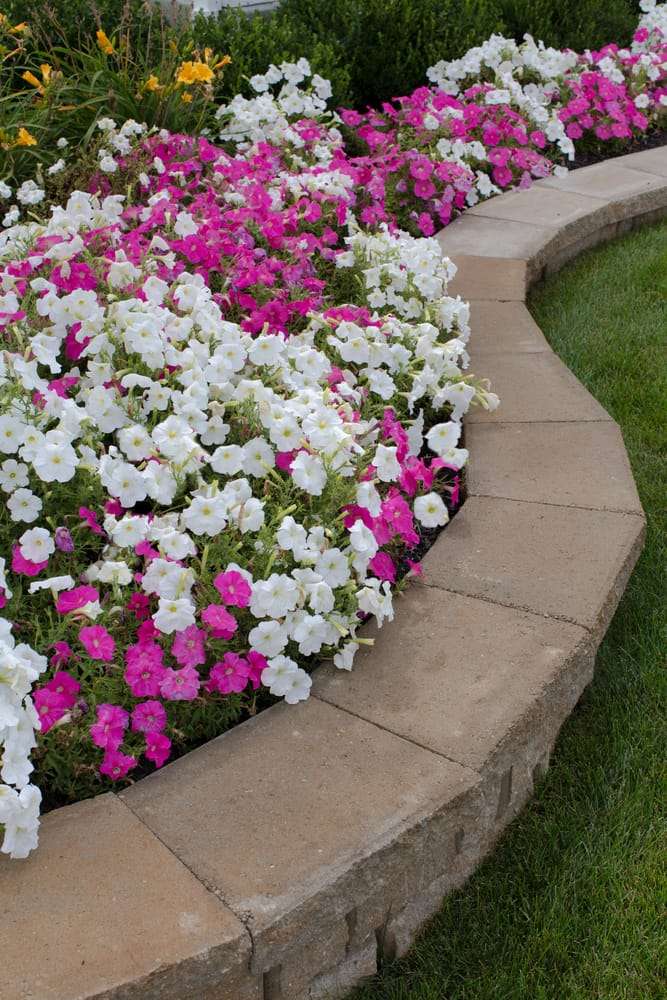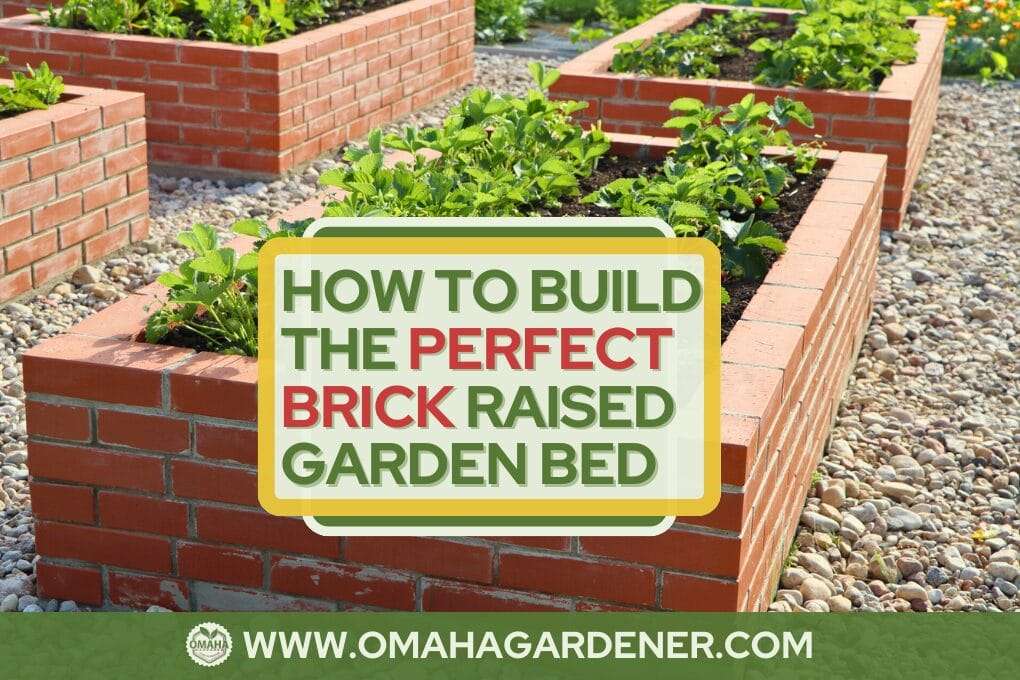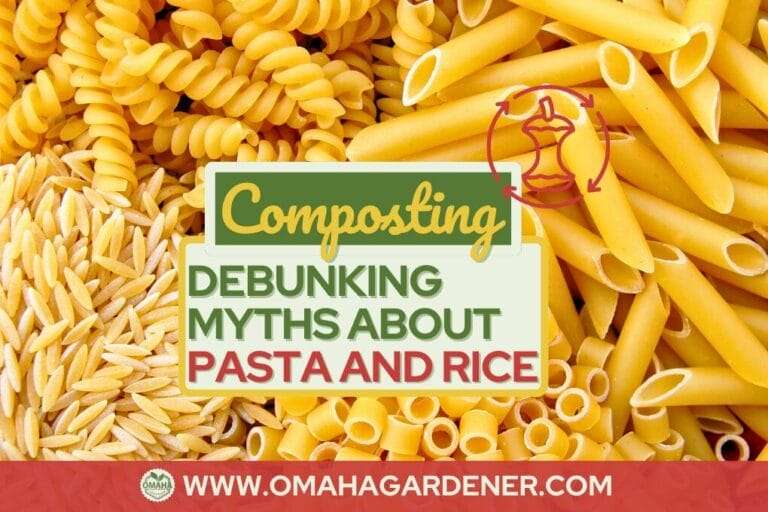
Have you ever dreamed of creating a long-lasting, visually appealing garden bed that not only stands the test of time but also adds a touch of elegance to your outdoor space? Brick-raised garden beds are the answer! In this guide, we'll walk you through a step-by-step process to build the perfect brick-raised garden bed, ensuring your plants have a sturdy and stylish home.
Table of Contents
Why Choose Brick for Your Raised Garden Bed?

Gardening enthusiasts often grasp selecting the ideal material for their raised beds. Bricks, with their timeless charm and strong features, have been a gardener's favorite for ages. But why?
Comparing Brick Raised Garden Beds to Other Materials
Brick or Wood?
Looks: Brick gives that timeless beauty, always looking refined. Wood, on the other hand, can weather, taking on a silvered patina over time.
Sturdiness: Brick holds its ground against decay and little critters, while wood needs a little TLC now and then to stay fresh and decay-free.
Investment: Sure, brick might seem like a bigger spend upfront. But, considering their long life, they might just be worth every penny.
What about Brick vs. Metal?
Character: Metal beds shout modern chic. In contrast, brick whispers ageless elegance.
Temperature Control: Under a blazing sun, metal beds can heat your plants' roots. But bricks? They keep things comfortably cool.
Pitting Brick against Plastic:
Environmentally Speaking: Plastics can deteriorate, leaching unwelcome chemicals. Brick, being earth's own, remains chemical-free.
Aesthetic Appeal: There's no denying – brick has a premium, down-to-earth feel that's hard to beat.
Advantages of Brick-Raised Garden Beds
- Weather Warrior: Rain or sunshine, bricks endure without much wear.
- Ease of Care: Think of bricks as the low-maintenance friend in your gardening world.
- Customize Away: Whether you dream of a curved bed or a classic rectangle, bricks flex to your design whims.
- No More Pests: Some annoying garden visitors don't fancy bricks, making your gardening journey much smoother.
- Go Green: Especially when you opt for recycled bricks, you choose an eco-friendly choice.
Potential Drawbacks and Solutions
Now, while bricks might sound like a gardener's dream, there are a few hitches to consider:
- Price Point: Bricks can be wallet-heavy initially. Quick Fix? Hunt for local deals or salvage yards for budget-friendly options.
- Time is Money: Setting up a brick bed might interrupt your weekend. What to do? Make it a fun family activity or invite a gardening buddy over.
- Alignment Issues: If bricks are mislaid, they can be a tripping hazard. The Solution? Start with a level base or consider a professional touch for perfection.
All said the numerous advantages of brick-raised garden beds outweigh the few challenges. With their blend of beauty and brawn, bricks can elevate any gardening space, making the effort worth it.
Planning Your Brick-Raised Garden Bed
Crafting the perfect garden takes more than just enthusiasm. It's about thoughtful planning, an eye for detail, and the wisdom to harmonize with nature. Dive deep as we map the steps to lay the groundwork for a spectacular brick-raised garden bed.
Choosing the Perfect Spot
1. Light is Right: Observe your yard at different times of the day. Sun-loving vegetables and flowers generally need at least 6-8 hours of sunlight. If you're planting shade-loving plants, pick a dappled sun area.
2. Drainage Dynamics: Avoid places where water pools after heavy rain. Elevated brick beds already offer decent drainage, but placing them in naturally high-drainage areas is an extra perk.
3. Accessibility: Make sure it's a spot that's easy to reach with your garden tools and water source. Also, consider the view from your home; after all, your garden is a visual treat.
Deciding the Size and Shape
1. Start Small: If you're new to this, take your time with this. Begin with a modest-sized bed, and as your green thumb flourishes, you can expand.
2. Depth Discussion: For most plants, a depth of 12 inches is ample. However, deeper-rooted vegetables like carrots might appreciate a bit more depth.
3. ShapeShift: While rectangles and squares are popular and easy to plan, don't shy away from curves and circles for an aesthetic touch. Bricks, being versatile, allow you to experiment.
Designing Your Raised Garden Bed
1. Theme Dream: Whether it's a vibrant flower paradise, a serene herb oasis, or a practical veggie plot, having a theme will guide your planting decisions.
2. Layer Lover: Think about plant heights. Place taller plants at the back or center, mid-height ones in the middle, and shorter ones at the front edges.
3. Brick Beauty: Consider patterns in which you lay the bricks. The traditional stack, a staggered bond, or a herringbone pattern can add visual charm.
4. Natural Neighbors: Research which plants thrive together. Some plants repel pests for their neighbors, while others when paired, can hamper each other's growth.
Remember, the key is not just to build a garden but to craft a sanctuary. A place where every brick, every plant, every tiny insect has a purpose and contributes to the greater ecology. And when you step back and admire your handiwork, it won't just be a garden bed; it'll be a testament to your effort, love, and the wonders of nature.
Materials and Tools Required for Constructing a Brick Garden
Creating a brick garden bed is akin to crafting art: it combines the right tools, materials, and a pinch of patience. But before you start layering those bricks, ensure you have everything you need for a smooth construction journey.
Materials Checklist
1. Bricks: Opt for clay bricks as they're durable and can weather environmental elements gracefully. The quantity will depend on your bed's dimensions.
2. Landscaping Fabric: This helps prevent weeds from taking over your raised garden bed. Ensure it's of good quality to last for years.
3. Mortar or Construction Adhesive (Optional): For those who want a more permanent structure. However, dry stacking bricks can also work well.
4. Soil Mix: A blend of topsoil, compost, and other organic materials is ideal. The composition will vary based on what you're planting.
5. Mulch: Helps retain soil moisture and deters weeds.
6. Gravel or Crushed Stone: Placed at the base for improved drainage.
Tools Checklist
1. Rubber Mallet: For setting and levelling the bricks.
2. Shovel: Needed for digging the bed and moving soil.
3. Spirit Level: To ensure your brick walls are even.
4. Tape Measure: Precision is critical, especially when planning the layout.
5. Gardening Gloves: To protect your hands during the process.
6. Wheelbarrow: Handy for transporting soil, compost, and gravel.
7. Trowel: For spreading mortar (if you're using it) and planting.
Where to Purchase Materials: Best Options
1. Local Hardware Stores: They usually stock high-quality bricks, tools, and other construction materials.
2. Garden Centers: Beyond just plants, these centers often have soil, mulch, and sometimes even bricks tailored for garden projects.
3. Online Retailers: Websites like Amazon, Home Depot, or Lowe's offer various materials and tools. Make sure to read reviews before purchasing.
4. Specialty Brick Suppliers: If you're looking for a specific type or color of brick, speciality suppliers can be your best bet.
5. Reuse & Recycling Centers: Old bricks with a bit of history can add character to your garden. Plus, it's an eco-friendly choice.
6. Local Classifieds: Platforms like Craigslist or Facebook Marketplace might have individuals selling or giving away leftover construction materials.
Remember, each brick you lay and each tool you employ contributes to a living tapestry of green. With suitable materials, proper tools, and a vision, you're not just building a garden; you're crafting an ecosystem. Happy building!
Getting Ready to Construct Your Brick Garden
Constructing a brick garden is not just about stacking bricks. Like any great endeavor, the groundwork is crucial. Proper preparation ensures that your garden not only looks good but also thrives. Here's a concise guide to preparing your yard for its brick garden transformation.
Conditioning and Preparing the Ground
1. Clear the Area: Start by removing any grass, weeds, or debris from the area where you'll set up your brick garden bed. It's essential to start with a clean slate.
2. Test the Soil: It's a wise idea to test the soil's pH and nutrient levels. This will give you insights into whether you need to amend your soil for specific plants. Kits are available at local garden centres or online.
3. Leveling: Use a shovel and rake to level the ground. This ensures stability for your bricks and helps in preventing future issues like leaning walls.
4. Weed Barrier: Lay down a layer of landscaping fabric to deter weeds from growing into your brick garden bed. This fabric also allows water to drain while keeping the soil intact. We recommend Weed Barrier Fabric that is 6 x 300 FT Heavy Duty Landscape Fabric Ground Cover.
5. Base Layer: Depending on your preference, a base layer of gravel or crushed stone can be added for extra drainage. This step is beneficial in areas prone to heavy rainfall.
Marking the Bed Layout on your Yard
1. Define Your Vision: Before marking, visualize the shape and size you desire. Whether it's a simple rectangle, an intricate L-shape, or a creative curvy design, have a clear image in mind.
2. Use a Hose or Rope: These are excellent tools to outline the desired shape of your garden bed. They're flexible and can be adjusted until you're satisfied with the layout.
3. Measure Twice: Using a tape measure, ensure the dimensions are according to your plan. Remember, precision at this stage can save time and effort later.
4. Mark the Corners: Place a stake or a flag at each corner of the outlined area. This will serve as a guide when you start laying bricks.
5. Draw a Sketch: While optional, sketching your garden bed layout on paper can serve as a handy reference. Include measurements and any specific design elements you want.
6. Walk Around: Once marked, walk around the area, imagining the raised bed in place. Ensure it feels right in terms of size, accessibility, and aesthetics.
In all endeavors, preparation is vital. By spending time getting the ground ready and meticulously marking out your brick garden bed layout, you're laying the foundation for a flourishing green space.
Building the Brick Raised Garden Bed: Step-By-Step
Constructing a brick-raised garden bed can seem daunting, but with careful planning and the proper steps, it can be a straightforward and rewarding DIY project. Here's a step-by-step guide to ensure your brick garden bed is built to last. If you want to know about read our blog on how to make a raised garden bed.
Placing the First Layer of Bricks (Foundation)
- Clear the Area: Ensure the ground is free from grass, weeds, and debris. This provides a solid foundation for your bricks.
- Level the Ground: Using a shovel, even out the surface. The bricks need to sit flat to avoid any unstable spots.
- Lay the First Brick: Start from one corner and place your brick firmly on the ground.
- Check for Level: Using a spirit level, ensure the brick is flat. Adjust as necessary by adding or removing soil underneath.
- Continue Placing Bricks: Lay the bricks end-to-end, ensuring they fit snugly against each other.
- Complete the First Layer: Finish the foundation layer by placing bricks in your desired shape, whether it's rectangular, square, or another design.
Building the Walls: A Layer-by-Layer Guide
- Start the Second Layer: Begin this layer by offsetting the bricks. This means the middle of the brick on the second layer should sit over the joint of two bricks on the first. This pattern enhances the structure's stability.
- Apply Adhesive: If you're using an adhesive, apply a thin layer on the bottom of each brick. This ensures they stick to the bricks below. However, this step is optional; some prefer beds without adhesive for easy modifications later.
- Stack Bricks Carefully: As you build upwards, ensure each brick sits level and fits tightly against its neighbors.
- Repeat the Process: Continue stacking and offsetting bricks until you reach your desired height.
Finishing Touches and Precautions
- Top Layer: The top layer of bricks can be set with a slight inward slant to help retain soil. This is a stylistic choice, but it can also be functional.
- Check Stability: Gently push against the walls of your brick bed to ensure they're sturdy. If there's any wobble, adjust as needed.
- Drainage: Ensure there's adequate drainage to prevent waterlogging. If you're building on a non-porous surface, consider drilling small holes at the base or setting a layer of gravel before adding soil.
- Soil and Planting: Add a mix of topsoil and compost to your brick-raised garden bed. This combination is typically ideal for most plants. Once filled, it's time to plant your desired flowers, herbs, or vegetables.
- Safety: If you've used adhesive, ensure it's non-toxic and safe for gardening. Always wear gloves and protective eyewear when constructing to avoid injury.
Constructing a brick-raised garden bed is not just about stacking bricks. It's about creating a robust, long-lasting structure where plants can thrive. By following this guide, even those new to DIY projects can build a bed as both a functional garden space and a beautiful landscape feature.
Helping Your Brick Garden Flourish
Gardening is not just about constructing a beautiful and robust bed; it's also about ensuring what's inside thrives. Once your brick garden is set up, the real fun begins: planting and maintenance. With the right strategies, your brick garden will not just look stunning—it will be a thriving ecosystem.
Choosing the Right Soil Composition
Every plant has its preferred type of soil. But for a raised brick garden, it's crucial to select a soil mix that provides good drainage while retaining enough moisture for the plants. A blend of topsoil, compost, and coarse sand typically works well. The compost adds essential nutrients, while the sand promotes drainage, ensuring roots don't get waterlogged. Before filling your bed, do a quick research on the plants you intend to grow and adjust the soil composition accordingly.
Deciding What to Plant: Vegetables or Flowers?
Your brick planter can host a variety of plants, from vibrant flowers that allure pollinators to delicious vegetables for your kitchen. When choosing what to plant:
Flowers: They not only beautify your planter but can also act as natural pest repellents. Beginners might find it easier starting with resilient flowers like marigolds or sunflowers.
Vegetables: There's something special about the flavor of vegetables you've grown yourself. In brick planters, lettuce, tomatoes, and bell peppers are popular picks. If space is a concern, look to vertical-growing veggies like beans and peas.
Whatever you decide, it's your personal touch that matters most. You can mix different plants or assign dedicated spots for each type. The main goal is to cultivate a garden that brings you happiness and fulfillment.
Watering and Maintaining Your Raised Garden Bed
Consistent watering is key. Raised gardens, especially those in brick structures, tend to dry out faster. However, they also offer excellent drainage, meaning there's less chance of over-watering. To strike a balance:
- Use a watering can or hose with a gentle spray setting, ensuring even water distribution.
- Water early in the morning or late in the afternoon to reduce evaporation.
- Monitor the soil moisture regularly. If the top inch feels dry, it's time to water.
- For maintenance, regularly check for weeds and remove them to ensure your plants get all the nutrients. Also, watch for pests and opt for natural deterrents when possible.
In the journey of gardening, patience is your friend. Watch, learn, and adjust as your plants grow, and soon, you'll have a flourishing brick garden that's the envy of all.
Another of one our recent articles you may like: The Effortless Garden: Top 25 Low Maintenance Landscaping Strategies
Troubleshooting and Common Issues
Gardening can be such a rewarding experience, especially when you have a beautiful brick-raised garden bed. But sometimes, issues arise that can turn that serene oasis into a source of stress. Don't worry; many gardeners have faced these problems before. Let's delve into some common issues and how to address them.
Dealing with Leaning Walls
One of the annoyances you might encounter is leaning walls. This not only affects the aesthetics but also the bed's functionality. Here's how to address it:
- Check the Foundation: Often, uneven ground or a poor foundation can cause walls to lean. Ensure that your bed is built on level ground.
- Reinforce with Stakes: Wooden or metal stakes can add stability. Just drive them into the ground on the inside of the wall and attach them securely.
- Inspect for External Pressure: If plants or soil are pushing against one side, it might cause leaning. Make sure to balance out the weight.
Addressing Soil Erosion
Heavy rains or watering can sometimes cause soil in your brick garden bed to wash away, a problem known as erosion. Here's how to combat it:
- Add Organic Matter: Materials like compost or leaf mould can improve soil structure, making it less prone to washing away.
- Plant Ground Cover: Low-growing plants or a green “carpet” of vegetation can help hold the soil in place.
- Install Edges or Barriers: Sometimes, a simple barrier can redirect water flow, preventing it from washing your soil out of the bed.
Fighting Pests and Diseases
Ah, pests and diseases, every gardener's arch-nemesis. They love your plants just as much as you do, but for all the wrong reasons. Here's what you can do:
- Natural Predators: Introduce beneficial insects like ladybugs or praying mantises that eat pests.
- Companion Planting: Some plants, like marigolds, can deter pests. Plant them alongside your veggies or flowers.
- Regular Inspection: Frequently check plants for signs of disease. If you see any, remove the affected parts immediately.
- Natural Remedies: Instead of reaching for chemicals, consider organic solutions like neem oil or insecticidal soaps.
Remember, problems in the garden are just opportunities to learn. With each issue, you become a more experienced gardener, ready to tackle any challenge. And with these solutions in your toolkit, your brick-raised garden bed will not only look great but also thrive!
Cost and Comparison
As mentioned, creating a flower bed using different materials like brick and wood comes with its own set of advantages and disadvantages, impacting aspects like durability, cost, maintenance, and aesthetic appeal. Let's outline a comparison in a table to help visualize the differences between building a 4×12 (dimensions in feet) flower bed using these two materials.
| Criteria | Brick | Wood |
|---|---|---|
| Durability | High. Bricks are resistant to rot and pests, and can last for decades with minimal upkeep. | Moderate to high, depending on the type of wood. Treated wood lasts longer but may require re-treatment or sealing. |
| Cost | Higher initial cost. Rough estimate: $500 – $1,000 for materials and labor. | Lower initial cost. Rough estimate: $200 – $600 for materials and labor. |
| Maintenance | Low. Brick is resistant to decay and does not require frequent maintenance. | Moderate. Wood may need to be treated or sealed regularly to prevent rot and pest damage. |
| Aesthetic | Offers a classic, sturdy appearance. Color and texture depend on the type of brick used. | Warm, natural look. Can be painted or stained to match any aesthetic. |
| Installation | More complex and time-consuming. Requires a solid foundation and skills in masonry. | Easier and faster to install. Can be a DIY project with basic tools and skills. |
| Environmental | Less environmentally friendly due to the energy-intensive production process of bricks. | More sustainable, especially if sourced from certified sustainable forests. However, treatment chemicals can be a concern. |
| Flexibility | Fixed shape and less adaptable once installed. Demolition and removal can be challenging. | Easier to modify, expand, or dismantle. Wood allows for more creativity in design changes. |
| Insulation | Provides good insulation for plant roots against temperature extremes. | Offers moderate insulation. Thickness and type of wood can affect insulation properties. |
These estimates assume a fairly straightforward project without significant landscaping challenges. The cost of brick can be higher due to the materials themselves and potentially higher labor costs for installation. Of course you can find used bricks on FaceBook Marketplace, Craigslist, local listings etc. Wood, while generally cheaper, can vary in cost depending on the type (e.g., cedar is more expensive but more resistant to decay than pine). Additionally, these estimates do not account for any additional landscaping you might need, such as soil, landscape fabric, or decorative elements, which could add to the overall cost.
Conclusion
Embracing the art of gardening within a brick-raised bed offers a unique blend of beauty, practicality, and reward. As with any gardening venture, challenges might arise, from leaning walls to pesky invaders. Yet, with knowledge, patience, and a touch of creativity, these hurdles become stepping stones to mastering the craft. Whether you're nurturing flavorful veggies or cultivating vibrant blooms, the journey is filled with lessons and joys alike. With the right care, your brick raised bed is more than just a structure; it's a testament to nature's resilience and your dedication. So, dive into this gardening adventure, armed with insights and passion, and watch your little oasis flourish.



